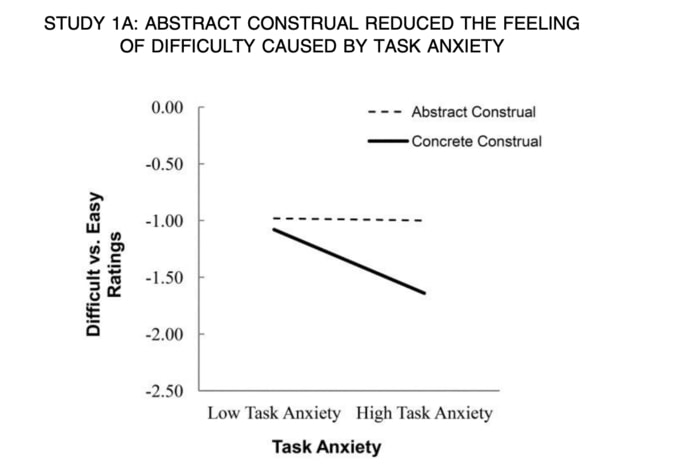In the world of business, we’re often given conflicting advice - particularly those of us with a consuming addiction to business blogs and e-zines. From endless advice on SEO to feng shui’ing the workplace, for every article you find telling you to do one thing, you’ll find another telling you the opposite. For the most part, the only exception to this rule is that of momentum - wherever you happen to find your information, most ‘experts’ will tell you that getting ahead, growth and expansion are, without a doubt, the only way to go. Although it makes sense that your ultimate goal will be to evolve your business, is forward the only direction that can achieve this?
The Perception Game

In a 2011 experiment, researchers from Cornell and Roman universities, set out to examine the effect that distance has on our ability to untangle a problem. During the experiment, participants were tasked with reading aloud a series of hard to pronounce words which were presented on a computer screen. Half of the respondents were instructed to lean toward the screen whilst the other half were asked to lean back. The experiment concluded that those who put distance between themselves and the problem by leaning back were better able to tackle the problem. As running a business is, essentially, made up of tackling problems on a regular basis, are there lessons to be learned from this unconventional experiment? We’re not, of course, suggesting that employees are forced to work ‘socially distanced’ from their computers (we wouldn’t want to be responsible for the optician bills, for a start), however, taking a metaphorical step back can be incredibly beneficial in getting ahead. Thus, resulting in a company’s long term success. Unfortunately, we’re very much conditioned to see a backward step as a step toward failure. While this can sometimes be the case, we’re living through unprecedented times whereby the only rule is that there are no longer any rules!
Stick to What You do Best
For businesses which produce physical products, there’s always the temptation to keep adding to the product range and offerings. Often, the philosophy is that a wider range of options will lead to increased sales for the company. In reality, what often happens is that the business ends up ‘spreading themselves too thin’ in terms of resources and suffers decreased sales as a result. Instead, it’s much more productive to take a step back in order to look at your existing products and then see how they can be improved. This not only keeps your costs down but, it also places you as an industry leader when you become known for doing one thing - and doing it well. One company who uses this methodology to great effect is tech giant, Apple. One of the most successful companies on the planet, you can pretty much fit all of its available products on one table - and a fairly small table at that. The secret to Apple’s success is in its simplicity - it worked out what its customers want and gave it to them - nothing more. Although the business does, of course, regularly upgrade its products, the fundamental core of its product range more or less remains the same. Not only is it sensible to shelve plans for new products but, it’s also worth considering discontinuing any products that don’t do as well as others. This was a plan which McDonalds benefited from in 2015 when it decided to ‘get back to basics’ and axed seven new sandwiches from its menu.
Scale The Team

When your business starts to see some success, a lot of owners react by scaling the team by taking on extra employees. Although business expansion will, inevitably, bring with it a requirement for more people, you don’t necessarily need to invest in tons of new hires. By being smarter about getting ahead in your business, you can save money and stay true to your core values more easily. Many businesses these days enjoy the benefits of outsourcing for a number of activities including software development and IT - which allows them to only pay for staff when they need them and, allows them to maintain a small, tight-knit, in-house team.
Know Your Limits
If your business has enjoyed rapid success, you may feel that the sensible thing to do is to invest the profits in equally rapid expansion. This can prove to be a huge mistake even for those with a huge amount of experience in getting ahead. One example of this was seen last year when celebrity chef, Jamie Oliver, lost 22 restaurants as Jamie's Italian chain went into administration. Oliver, who has been a chef and restaurateur since 2008, enjoyed phenomenal success with Jamie's Italian range so, what went wrong? Sadly, this was a simple case of a brand expanding too rapidly without adequately reading the landscape - and an error which, ultimately, resulted in the end of the chain and, the loss of 1000 jobs. In a case like this one, instead of continuing to open more and more restaurants, the chain would have benefited from scaling back and then concentrating on improving and developing the experience for diners.
Stripping Down
Launching a successful business can be really exciting but, at times, it can also feel like you’ve created a monster. Many entrepreneurs start off in one room (often a bedroom) and, getting the business up and running takes a lot of long hours, tons of dedication and passion and a huge amount of fun. A common problem is that, when a business experiences fast and furious growth, it can bring with it lots of cash - and even more headaches. With great power comes great responsibility, as they say and, in this situation, some business owners complain that the passion and fun is replaced with constant frustration and number crunching. Whoever said that you can’t go back in business was dead wrong. In this situation, it’s absolutely vital to get some distance and to see what you can do to reclaim the passion that you first felt for your business. As with some of the other points in this article, this may be a case of scaling back your product development or putting further expansion plans on hold for a while. In extreme cases, some entrepreneurs choose to sell the business and start again with a new project. Although this may seem like a nice problem to have, it can be incredibly stressful watching your ‘baby’ turn into a corporate machine that you barely recognise and, the goal is to strike a balance between success and still enjoying doing your thing.

The Reboot
They say that a lot of marriages experience the seven-year itch whereby things start to feel a little stale and ‘the thrill is gone’. For many, the same can be said for a business to a certain extent in getting ahead. After an initial amount of growth, it’s normal for a business to plateau in terms of sales and success. Whilst this is not necessarily a bad thing, many owners find that they end up ‘trundling along’ with the business with things ticking over well enough. The danger here is that, while the business owner is resting on his or her laurels, new businesses are arriving, offering new products and improved service. This kind of business holding pattern is more common than you might think and, as the brand stagnates, the business starts to fall further and further behind. While this doesn’t by any means spell the end of the business, it may mean that a complete reboot is required. Not as scary as it sounds, this is something that can be done relatively quickly and easily: Take a break - Your first step, if possible, is to close the business for a short time. It then makes sense to take a couple of weeks out in order to recharge your batteries - and your creativity. Take a bird’s eye view - After your break, take the time to properly research your competition to find out what they’re doing well and, more importantly, what they’re doing better than you are. If you’ve been letting things slide, this kind of research is absolutely essential in giving you an idea of the kind of work which may be involved in rebooting your business. School of thought - It may be that the stagnation of your business is down to the fact that you haven’t been keeping up with the latest techniques and technology. Now’s the time to change all that. Learning about the latest methods is an invaluable investment that is necessary for the health of your reboot. Get the lowdown - Although you may have a pretty good idea of what’s gone wrong with your business, chances are that you’re a little too close to it to see the whole picture. At this stage, it’s a really good idea to get hold of a sentiment analysis tool which will allow you to sweep the internet for mentions of your brand and, let you know what people think about it - the good, the bad and the indifferent. This kind of sneaky feedback is incredibly helpful when looking to take a step back - and a step up - for your brand. The re-brand - Particularly important if your product or service has become outdated and irrelevant, a re-brand helps you to highlight the fact that your product or service has been brought up to date and, that your brand is entering a new, more modern phase. To this end, it’s vital that you invest in some great promotion to let the world know what’s new.





